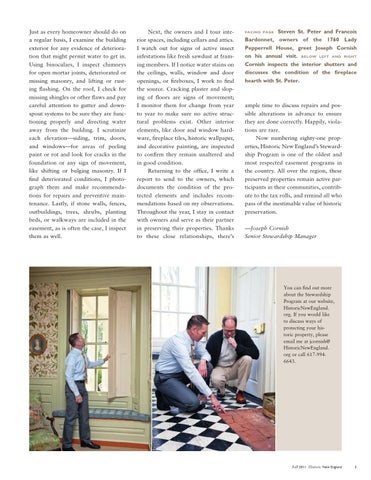Just as every homeowner should do on a regular basis, I examine the building exterior for any evidence of deterioration that might permit water to get in. Using binoculars, I inspect chimneys for open mortar joints, deteriorated or missing masonry, and lifting or rusting flashing. On the roof, I check for missing shingles or other flaws and pay careful attention to gutter and downspout systems to be sure they are functioning properly and directing water away from the building. I scrutinize each elevation—siding, trim, doors, and windows—for areas of peeling paint or rot and look for cracks in the foundation or any sign of movement, like shifting or bulging masonry. If I find deteriorated conditions, I photograph them and make recommendations for repairs and preventive maintenance. Lastly, if stone walls, fences, outbuildings, trees, shrubs, planting beds, or walkways are included in the easement, as is often the case, I inspect them as well.
Next, the owners and I tour interior spaces, including cellars and attics. I watch out for signs of active insect infestations like fresh sawdust at framing members. If I notice water stains on the ceilings, walls, window and door openings, or fireboxes, I work to find the source. Cracking plaster and sloping of floors are signs of movement; I monitor them for change from year to year to make sure no active structural problems exist. Other interior elements, like door and window hardware, fireplace tiles, historic wallpaper, and decorative painting, are inspected to confirm they remain unaltered and in good condition. Returning to the office, I write a report to send to the owners, which documents the condition of the protected elements and includes recommendations based on my observations. Throughout the year, I stay in contact with owners and serve as their partner in preserving their properties. Thanks to these close relationships, there’s
steven st. peter and Francois bardonnet, owners of the 1760 Lady pepperrell house, greet Joseph Cornish on his annual visit. bELoW LEFt AND rIGht Cornish inspects the interior shutters and discusses the condition of the fireplace hearth with st. peter.
FACING pAGE
ample time to discuss repairs and possible alterations in advance to ensure they are done correctly. Happily, violations are rare. Now numbering eighty-one properties, Historic New England’s Stewardship Program is one of the oldest and most respected easement programs in the country. All over the region, these preserved properties remain active participants in their communities, contribute to the tax rolls, and remind all who pass of the inestimable value of historic preservation. —Joseph Cornish Senior Stewardship Manager
You can find out more about the Stewardship Program at our website, HistoricNewEngland. org. If you would like to discuss ways of protecting your historic property, please email me at jcornish@ HistoricNewEngland. org or call 617-9946643.
Fall 2011 Historic New England
29131.indd 3
3
11/17/11 6:19 PM
